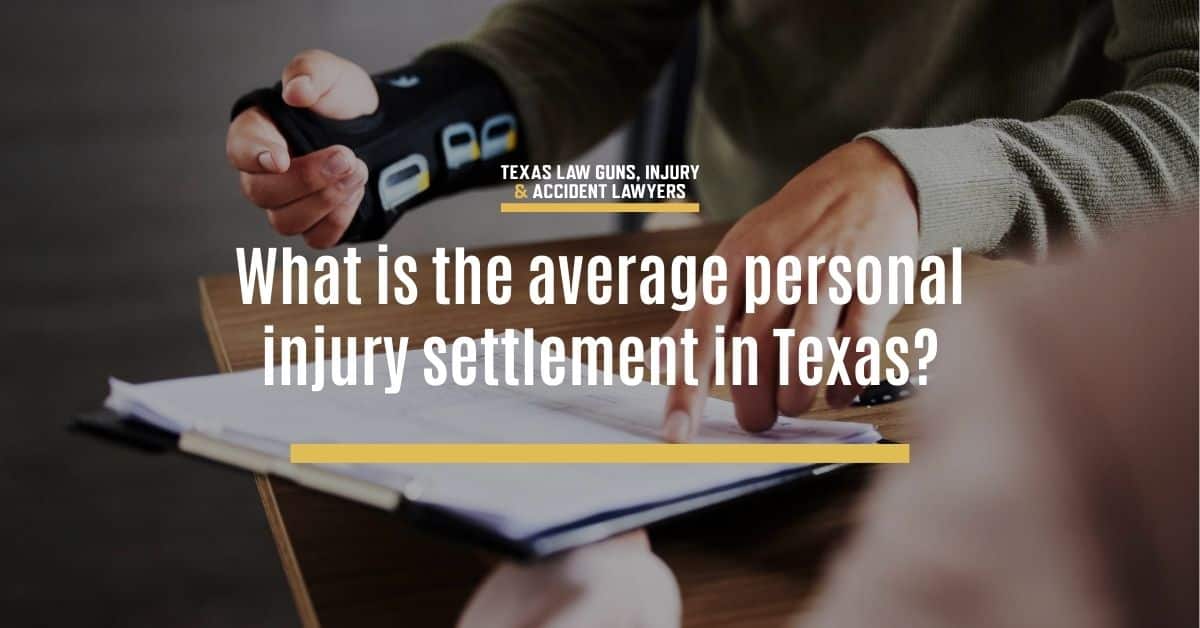If you’ve been injured in an accident, you’re likely wondering how large of a financial settlement you can expect. It’s a fair question: when you’re looking at months of medical treatment and extended time away from work, financial worries are going to set in. What is the average personal injury settlement in Texas, and will you receive the same amount or something different?
According to a Research study, the average verdict in a Texas personal injury lawsuit is $826,892, but that’s for cases that make it to trial. Settlements can be equally high, especially for serious cases like traumatic brain injuries, but the average settlement tends to be lower. In this article, we’ll go over what you need to know about these compensation calculations and how a Texas personal injury lawyer can help.
Average Personal Injury Settlements in Texas
No two accidents are exactly alike, which is why there’s no standard settlement involved. How much you receive depends on what happened, who was at fault, and the extent of all associated injuries and property damage. Below is an overview of average payouts for different accident types:
- Car accidents: $23,000 (in Texas)
- Truck accidents: $383,000 (nationwide)
- Motorcycle accidents: $99,000 (nationwide)
- Pedestrian accidents: $60,000 (nationwide)
It is important to note that these are only averages: a car accident that leaves you with catastrophic injuries and/or permanent disability will have a higher value than one involving comparatively minor injuries like bruising, lacerations, and muscle sprains.
How Texas Calculates Personal Injury Settlements
In Texas, personal injury compensation is divided into two main types: economic and non-economic damages:
- Economic damages are straightforward to calculate and include bills, receipts, and documented losses like ambulance costs, surgeries, physical therapy, prescription medications, and the income you missed during your recovery period. Since they are all measurable losses with paper trails, insurance adjusters rely on them as a baseline for calculations.
- Non-economic damages are harder to evaluate, but no less real or distressing. They cover the mental and physical toll of a bodily injury: things like pain and suffering, chronic discomfort, emotional distress, or loss of enjoyment of life. These damages reflect how your injury changes your day-to-day experience, not just your finances.
When evaluating your claim, insurance adjusters and personal injury attorneys assess more than just the injury itself. They look at key factors like how long you’re expected to be in treatment, what kind of long-term care you’ll need moving forward, and whether you’re ever going to fully recover. They also review fault and whether there’s enough insurance coverage to support the full value of your damages. Generally speaking, the stronger the evidence, the more pressure there is on the opposing party to settle for a fair amount.
Severity of Injuries Impacts Settlement Size
The more serious the injury, the more your case is likely worth. A sprain or minor soft tissue injury may lead to a small payout, but a broken bone or spinal cord injury changes the equation. Severe injuries often involve longer recovery, high treatment costs, and ongoing care, which can dramatically raise the value.
For example, if you suffer a spinal injury that limits your mobility, your settlement will likely account for physical therapy, chiropractic therapy, adaptive devices, and in-home support. Injuries like traumatic brain damage or paralysis can push the settlement into six or seven figures. These numbers reflect the wide reach of medical bills, lifestyle changes, and future support needs.
Soft tissue cases, like mild whiplash or pulled muscles, tend to heal faster. They don’t require the same amount of medical care, so insurance companies settle those accident claims more quickly. But once an injury interferes with your ability to carry out daily activities or creates pain that doesn’t go away, the insurance claim takes longer to settle and usually ends with a higher average payout.
Medical Costs Carry Major Weight
Medical expenses are one of the most important parts of any personal injury claim. This includes ER visits, surgeries, medication, follow-up appointments, and therapy. Every bill you collect adds value to your case, so be sure to save receipts, doctor’s notes, and any written ongoing treatment plans. Even mileage to and from appointments can count toward your claim if tracked properly. Accurate documentation makes your claim stronger and harder for insurers to challenge.
Missed Work and Long-Term Income Losses
Missing work due to an injury can quickly lead to financial hardship, but Texas law lets you claim those lost wages. This includes hourly or salaried pay, freelance income, bonuses, and commissions. If your job offers paid time off, you can recover the value of those days, too.
If your injury forces you into a different career or reduces your hours, you can also claim lost earning capacity. This involves calculating how much you would have earned in your lifetime had the injury not happened. In cases where you can’t return to work at all, the future wage loss can be considerable. These numbers often become the backbone of high-value accident settlements. They don’t only reflect what you’ve lost; they show what you won’t have the chance to earn.
Pain and Suffering Adds Emotional Weight
Pain and suffering refer to the physical pain and emotional trauma caused by the injury. This includes daily discomfort, stress from limited mobility, or mental health conditions like anxiety or PTSD. These damages are real, even though they aren’t measured with a receipt.
Insurance adjusters often calculate pain and suffering using a multiplier tied to medical expenses. For example, if your medical bills total $50,000, the multiplier might be 1.5 to 5 depending on severity. That means pain and suffering could add $75,000 to $250,000 to your accident injury settlement.
To prove pain and suffering, you’ll need evidence like journals, medical care and therapy records, and statements from family or friends can help show how your daily life has changed for the worse. The more credible your story, the harder it is for insurers to push back.
Fault and Liability Adjust the Final Total
Texas follows a modified comparative negligence rule, which means that your settlement changes if you’re partly at fault. If you’re partly responsible for the accident, your settlement amount is reduced by your share of the blame. For example, if you’re awarded $100,000 but a court finds you 30% at fault, you’d receive $70,000 instead.
This rule also dictates whether you can file a compensation claim at all. If you’re found to be 51% or more responsible, you’re barred from receiving any payment, even if the other party was also careless. This can apply in cases like car accidents, slip and falls, or other personal injury claims where both sides played a role.
That’s why gathering strong evidence is so important. Photos, witness statements, police reports, and video footage all help prove what really happened and who the at-fault party or parties are. However, even if liability seems clear, you can expect the other side to argue. They want to reduce their payout, and blaming you is one of the fastest ways to do it. The stronger your case, the harder it is for that tactic to succeed.
Insurance Policy Limits Set a Cap
In many cases, the other person’s insurance coverage limits how much you can recover. Texas requires drivers to carry at least $30,000 per person and $60,000 per accident. If the damages go beyond that, you’ll need to explore other options. This might include:
- Tapping into your own underinsured motorist coverage, or;
- Suing the at-fault party directly
Sometimes there are multiple parties who share fault, which opens up more sources of financial compensation. Your accident attorney can help track down every available insurance policy.
Understanding these limits early on helps manage your expectations. If the at-fault party’s insurance policy maxes out, that might be the ceiling unless someone has personal assets worth pursuing. The more coverage there is, the more room there is to negotiate.
Wrongful Death Settlements in Texas
When someone dies due to negligence, surviving family members can pursue a wrongful death claim against the responsible party or parties. This type of case includes both financial losses and emotional damages arising from fatal injuries. In Texas, spouses, children, and parents can file these claims.
Wrongful death cases can result in larger settlements, especially if the deceased was a high earner or left behind dependents. Fair compensation may include:
- Lost income
- Medical expenses (for medical treatment before death)
- Funeral expenses
- Loss of companionship (loss of consortium)
- Emotional distress
- Property damage
The law also allows for punitive damages in cases of gross negligence. For example, if your loved one was struck and killed by a drunk driver with a long history of DUI arrests, your wrongful death lawyer can seek this additional compensation on your behalf.
Wrongful death claims often take longer to resolve, but the maximum compensation can be much higher. That’s because the economic and non-economic losses go beyond hospital bills and touch every part of your family’s life forever.
Jury Verdicts vs. Personal Injury Settlements
Most injury claims in Texas are resolved through settlement before reaching a courtroom. Settlements are the ideal outcome because they’re quicker to reach and give both sides more control over the outcome. But when an insurance company refuses to offer a fair amount, taking the case to trial may be your best option.
Jury trials can lead to larger awards, especially when the injury has had a long-term impact or when the defendant’s actions were clearly reckless. Insurance companies, knowing that risk, often raise their offers to avoid letting a jury decide the outcome. The chance of a trial, especially one backed by strong evidence and a prepared legal team, gives you more leverage at the negotiation table.
If your case moves toward court, your personal injury lawyer will help you weigh the options carefully. That includes how strong your claim is, how much the insurer is offering, and what the next steps might look like. In many high-value cases, fair settlements often happen right after the other side sees that you’re ready to let a jury decide the outcome.
Questions About Average Personal Injury Settlement Amounts in Texas?
The average settlement amount in Texas varies based on the case type and extent of your injuries, but when you’re looking at a long and painful recovery, you want as much money as possible to help you heal and rebuild your life. That’s where an experienced lawyer can make a difference.
At The Texas Law Guns, Injury & Accident Lawyers, we’ve handled thousands of personal injury claims across Texas. Our team takes on insurance companies, builds strong cases, and fights for the full value of your claim. We don’t back down, and we don’t get paid unless you win. To schedule a free, confidential consultation with an experienced injury attorney, call our law firm at (210) 800-0000 today or fill out our online contact form today.

Alexander Begum has tried over 50 trials to verdict and tried or settled over $500 million in cases. Alex is a founding shareholder of the Texas Law Gun, Injury and Accident Lawyers.




